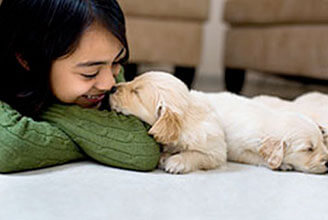Footsteps and barking
You and your neighbors don't want your pup to yelp every time someone walks by. To teach your dog not to bark when they hear footsteps, have a family member or neighbor walk by your door several times. Train your pup to lie down and stay; dogs tend not to bark as much when they’re laying down. Barking is usually the main problem when you and your puppy live in a multi-home dwelling. Dogs often feel threatened and territorial when they hear noises and footsteps outside their safe space, hence, barking.
Every time your puppy follows your command and stops barking at the footsteps, reward him with a treat. Practice this a few times every day until your little guy learns how to control his vocalizations.
Here are some more barking-modification tips from Doctors Foster & Smith:
- Train in short, five to ten-minute sessions as you teach your pup to lie down and not bark.
- Don’t shout "No!” when your pup barks. It often makes matters worse because your puppy may think you’re joining in and barking too.
- Pick a one-word command like “stop” or “enough” and always use that word in a calm tone of voice when your pup barks excessively. Everyone in your home should practice the same command using the same tone.
- Positive reinforcement is more powerful than punishment. Using healthy treats is fine but sometimes rewarding with verbal praise and hugs is even better.
- When your puppy barks excessively, don’t play into it with hugs or soothing comments. This can reinforce his behavior because he may feel there really is something to be alarmed about, which may worsen his barking the next time.
- Always seek professional help from animal trainers, behaviorists and your veterinarian if your pup’s barking issues don’t improve.
Exercise, exercise, exercise
Dogs with yards aren’t necessarily more active than apartment dogs; they still need to go on frequent walks and don't always get that essential exercise.
In a way, apartment canines may actually take more walks because pet parents have to bring them outside for bathroom breaks. While outdoors, you may as well walk. Keep your pup on his leash, especially on crowded, noisy streets.
Dog parks are another great place to exercise your pup and teach him socialization skills with other humans and dogs. While leashed, slowly introduce your puppy to the pack. Dog parks are neutral territory so your pup shouldn’t feel threatened, but he may still be protective of you so let him sniff his way around gradually.
And, if you can’t always exercise your puppy yourself, ask around for a trustworthy, reputable dog walker who will take your dog out and about for his daily jaunt.
Be consistent with potty training
Whichever housebreaking method you try — crate, paper or outdoor training, be sure to stick to it so your pup doesn't get confused. It also helps to feed your dog on a regular schedule and take your pup outside to relieve himself first thing in the morning. Your pup will let you know when he has to go, so watch closely for cues like sniffing around, whimpering and standing by the door.
Stay current with vaccinations
Even if your complex doesn't have a common area, you're likely to bump into other residents and their furry family members. Vaccinations can help prevent diseases so it’s wise to keep your pup as healthy as possible and hopefully your neighbors will do the same.







